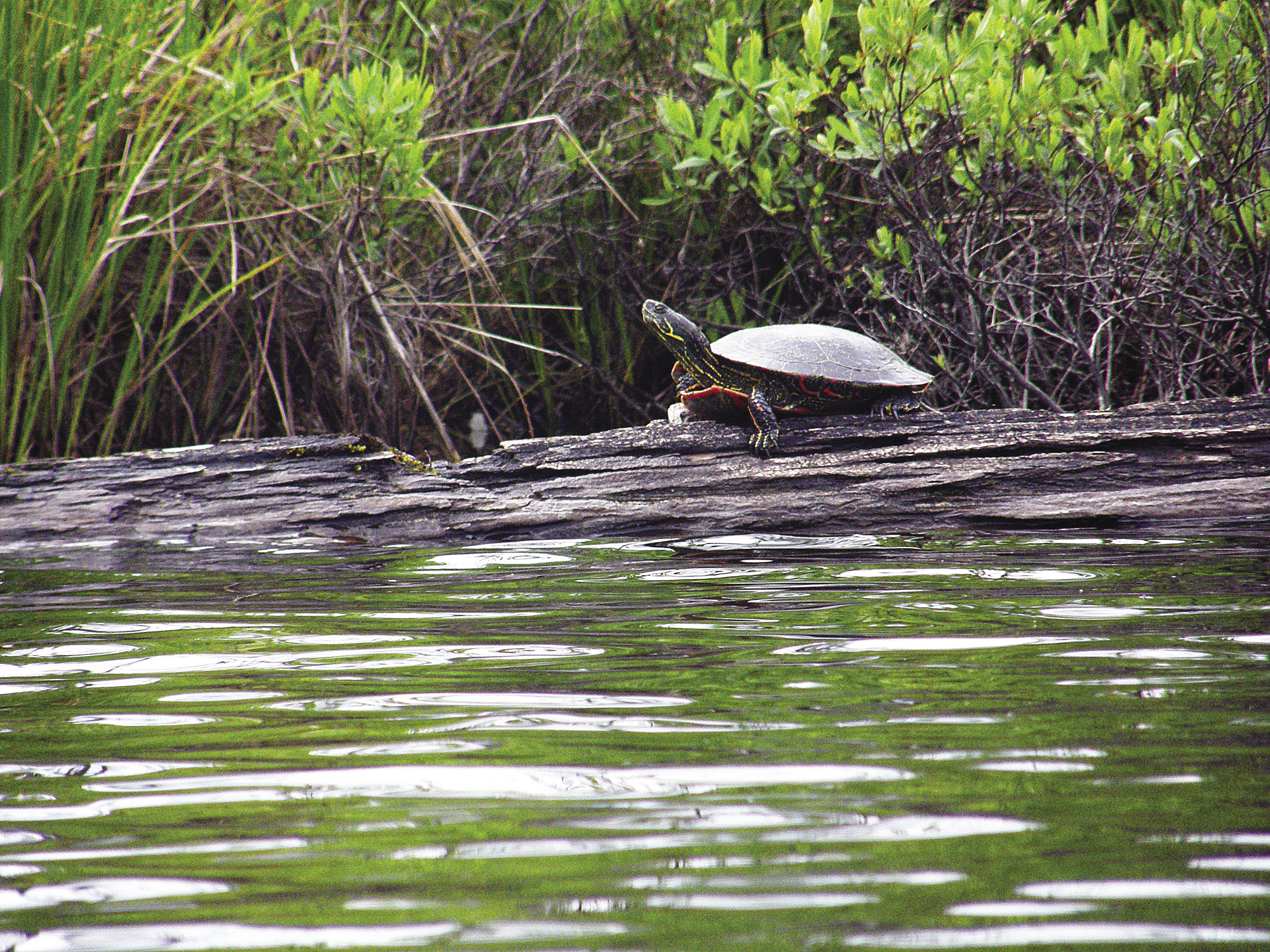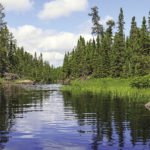When I’m finally called to the big fishing camp in the sky, there will be an alder swamp waiting for me. A celestial ghillie will outfit me with a fly rod, a box of flies, a pair of chest waders and hopefully some bug dope.
Then the ghillie will say, “Sir, if you head off into alders over there, you’ll find a beaver pond filled with 4-pound brook trout.”
And off I’ll go. Maybe I’ll find that brookie Shangri-La. Or maybe I’ll spend eternity crashing through the swamp, swatting swarms of black flies and cursing the ghillie who didn’t supply me with bug dope. Either way, I’ll know my fate.
I’ve spent a lot of time slogging through swamps, bogs, marshes and sloughs in many places and in all seasons. Often, my quest for trout has taken me there. When I was a kid, my father and I followed a path across a bouncy floating bog to try for brook trout in Lake County’s Section 8 Lake. I stepped around a puddle in the path. Dad stepped in it…and promptly sunk to his waist in oozing muck.
“Now I know why they call this lake Section 8,” the old infantryman growled. “You have to be Section 8 to go fishing here!”
Section 8, in case you are not of Korean War vintage, was a military term for mentally unfit for duty. Dad recovered from his mud bath and proceeded to go fishing. The brook trout were biting, which restored his humor, too.
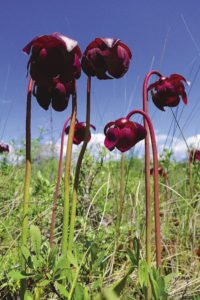
The Northern Wilds is a landscape washed with water. This is most apparent in our wealth of lakes and streams. By contrast, our wetlands (most people know them as “swamps”) are often underappreciated. But these sloppy, muddy, bug-infested places are the well springs of our watery bounty and the filters that keep the water fresh and clean. In other places, human development from urban sprawl to agriculture has led to the drainage and obliteration of wetlands. By contrast, the vast majority of Northern Wilds wetlands remain intact and largely protected from human encroachment. Activities such as logging occur in the winter, when heavy equipment can be operated on frozen swamps to prevent long term damage.
Have you ever walked a corduroy road? In the old days, loggers laid logs side by side to build roads across swamps, creating a natural platform to prevent horse drawn sleighs and, later, mechanized equipment from sinking into the mire. Preserved in the ooze, corduroy roads last for decades after the last load of logs rumbles over them. Very often they are the best way for a grouse hunter or some other backwoods wanderer to hike across a bog.
Peat bogs are the signature wetlands of the North. They are shallow basins that once were lakes or ponds, but over centuries and millennia slowly filled in with silt and vegetative matter through a natural process called eutrophication. A spongy layer of sphagnum moss grows over the peat. Some bogs support stands of black spruce and tamarack. Often the trees grow so slowly in a boggy environment that foresters refer to them as “stagnant” spruce.
When I was a kid, we once happened upon an old-timer who was using snowshoes in the summer to fish for brook trout in a creek flowing through a peat bog. Come to think of it, Dad should have been wearing snowshoes when we fished Section 8 Lake. I like to explore bogs in the winter, when you can snowshoe across a world few people visit. It’s quiet out there. You might see fox tracks or a raven may pass overhead, but a frozen bog is a place of lonely solitude.
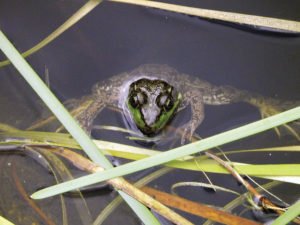
Not all wetlands are this way. A marsh teams with life, serving as a focal point for a plethora of creatures; some exist there, others live nearby and others, most often birds, make seasonal visits. In spring I like to walk my dogs along the high ground above an expansive open marsh. Although I can’t see them, I listen to the calls of trumpeter swans and sandhill cranes. Both species have become more numerous in the Northern Wilds during the last 20 years.
Sometimes on these walks I’ll happen upon an antler dropped by a moose the previous winter. Swamps are an important aspect of moose habitat. In summer, moose eat aquatic vegetation and seek shelter from the sun in the shady coolness of black spruce bogs. In autumn, you can often find the battered brush and muddy wallows that are the calling cards of rutting bulls along the perimeter of a swamp. Last March, I found where a moose had spent part of the winter in a swampy grove of ancient white cedar, browsing on the understory of alder, birch and balsam fir.
Wetlands, especially the ones where big cedars dwell, are among the least disturbed ecosystems on the Northern Wilds landscape. But change occurs in swamps, too. You can still see remnants from the early years of European settlement, when waterways were altered to facilitate logging operations. Lakes and streams were dammed to create a head of water for spring log drives. Dynamite blasts were used to create potholes in creeks for the storing logs and water. Swamps were ditched and drained to build roads and homes or to dry out land used for crops and pasture. These days we have rules in place to protect our water and wetlands from activities that may damage them or impair water quality.
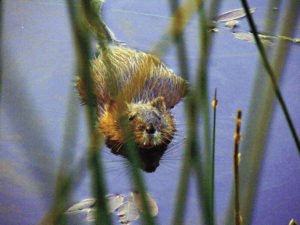
But no one regulates the beavers. Sometimes called “nature’s engineers,” these industrious rodents have been busy at work in the Northern Wilds for millennia. Beavers cut down trees with their teeth to build dams across flowing water, from tiny trickles to sizeable streams. On large rivers and lakes, they are content to build their homes of sticks and mud along the banks; no dam necessary. The ponds created by beaver dams create a new environment used by a host of species, from black ducks and kingfishers to brook trout and painted turtles.
Beavers harvest deciduous trees for food and building materials. Aspen is their favorite. Where the terrain allows, they’ll even dig canals leading out from their ponds so they can reach more trees. Eventually, they cut down all of the nearby trees and run short of food. At that point, they abandon the pond. The beaver dam falls into disrepair and water drains out of the pond, leaving the original stream bed surrounded by muddy ground. Grass and sedges sprout from the mud, creating a lush meadow. Over time, trees return. At some point, another beaver decides to rebuild the dam and the process comes full circle.
I’ve watched beaver ponds pass through every stage of this process, sometimes more than once. I am humbled by the way these natural occurrences mark the passing of time. Beavers have long existed on this landscape. Long may they continue to do so. And when the time comes for me to seek that celestial beaver pond, I hope I find it.


